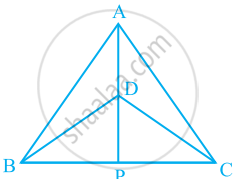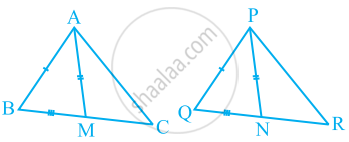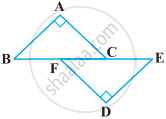Advertisements
Advertisements
Question
ΔABC and ΔDBC are two isosceles triangles on the same base BC and vertices A and D are on the same side of BC (see the given figure). If AD is extended to intersect BC at P, show that
- ΔABD ≅ ΔACD
- ΔABP ≅ ΔACP
- AP bisects ∠A as well as ∠D.
- AP is the perpendicular bisector of BC.

Solution
(i) In ΔABD and ΔACD,
AB = AC ...(Given)
BD = CD ...(Given)
AD = AD ...(Common)
∴ ΔABD ≅ ΔACD ...(By SSS congruence rule)
⇒ ∠BAD = ∠CAD ...(By Corresponding parts of congruent triangles)
⇒ ∠BAP = ∠CAP …(1)
(ii) In ΔABP and ΔACP,
AB = AC ...(Given)
∠BAP = ∠CAP ...[From equation (1)]
AP = AP ...(Common)
∴ ΔABP ≅ ΔACP ...(By SAS congruence rule)
⇒ BP = CP ...(By Corresponding parts of congruent triangles) …(2)
(iii) From equation (1),
∠BAP = ∠CAP
Hence, AP bisects ∠A.
In ΔBDP and ΔCDP,
BD = CD ...(Given)
DP = DP ...(Common)
BP = CP ...[From equation (2)]
∴ ΔBDP ≅ ΔCDP ...(By SSS Congruence rule)
⇒ ∠BDP = ∠CDP ...(By Corresponding parts of congruent triangles) …(3)
Hence, AP bisects ∠D.
(iv) ΔBDP ≅ ΔCDP
∴ ∠BPD = ∠CPD ...(By Corresponding parts of congruent triangles) …(4)
∠BPD + ∠CPD = 180° ...(Linear pair angles)
∠BPD + ∠BPD = 180°
2∠BPD = 180° ...[From equation (4)]
∠BPD = 90° …(5)
From equations (2) and (5), it can be said that AP is the perpendicular bisector of BC.
APPEARS IN
RELATED QUESTIONS
ABC is a right angled triangle in which ∠A = 90° and AB = AC. Find ∠B and ∠C.
Two sides AB and BC and median AM of one triangle ABC are respectively equal to sides PQ and QR and median PN of ΔPQR (see the given figure). Show that:
- ΔABM ≅ ΔPQN
- ΔABC ≅ ΔPQR

BE and CF are two equal altitudes of a triangle ABC. Using RHS congruence rule, prove that the triangle ABC is isosceles.
Prove that in a quadrilateral the sum of all the sides is greater than the sum of its diagonals.
In the following figure, BA ⊥ AC, DE ⊥ DF such that BA = DE and BF = EC. Show that ∆ABC ≅ ∆DEF.

ABC is an isosceles triangle in which AC = BC. AD and BE are respectively two altitudes to sides BC and AC. Prove that AE = BD.
In a right triangle, prove that the line-segment joining the mid-point of the hypotenuse to the opposite vertex is half the hypotenuse.
Line segment joining the mid-points M and N of parallel sides AB and DC, respectively of a trapezium ABCD is perpendicular to both the sides AB and DC. Prove that AD = BC.
ABCD is a quadrilateral such that diagonal AC bisects the angles A and C. Prove that AB = AD and CB = CD.
ABC is a right triangle such that AB = AC and bisector of angle C intersects the side AB at D. Prove that AC + AD = BC.
